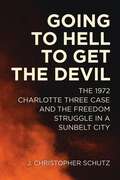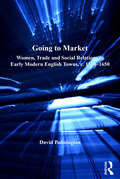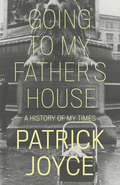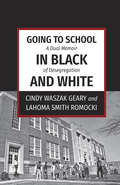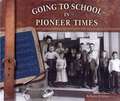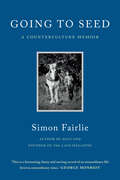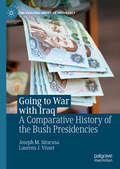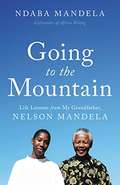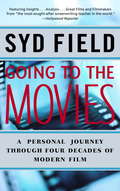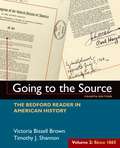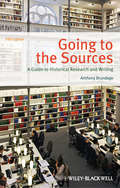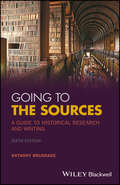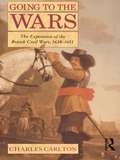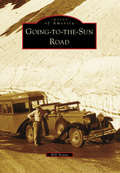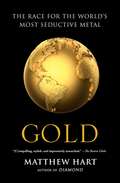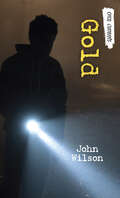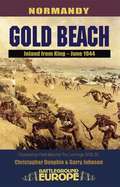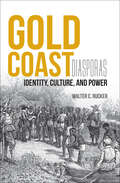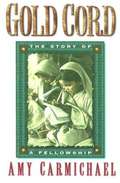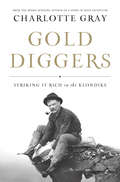- Table View
- List View
Going to Hell to Get the Devil: The 1972 Charlotte Three Case and the Freedom Struggle in a Sunbelt City (Making the Modern South)
by J. Christopher SchutzThe 1968 burning of the Lazy B Stables in Charlotte, North Carolina, attracted little notice beyond coverage in local media. By the mid-1970s, however, the fire had become the center of a contentious and dubious arson case against a trio of Black civil rights activists, who became known as the “Charlotte Three.” The charges against the men garnered interest from federal law enforcement agents, investigative journalists— including one who later earned a Pulitzer Prize for coverage of the trials—numerous New Left and Black Power activists, and Amnesty International, which declared the defendants “political prisoners.” In Going to Hell to Get the Devil, J. Christopher Schutz offers the first comprehensive examination of this controversial case and its outcome. In the 1960s and 1970s, Charlotte’s leaders sought to portray their home as a placid, business-friendly, and racially moderate community. When New Left and Black Power activists threatened that stability, city leaders employed a variety of means to silence them, including the use of law enforcement against African Americans they deemed too zealous. In the Charlotte Three case, prosecutors paid prisoners for testimony against the Black activists on trial, resulting in their convictions with lengthy prison sentences. The unwanted publicity surrounding the case of the Charlotte Three became a critical pivot point in the Queen City’s post–World War II trajectory. Going to Hell to Get the Devil tells more than the story of an arson case; it also tells the story of the South’s future, as the fate of the Charlotte Three became emblematic of the decline of the African American freedom struggle and the causes it championed.
Going to Market: Women, Trade and Social Relations in Early Modern English Towns, c. 1550-1650
by David PenningtonGoing to Market rethinks women’s contributions to the early modern commercial economy. A number of previous studies have focused on whether or not the early modern period closed occupational opportunities for women. By attending to women’s everyday business practices, and not merely to their position on the occupational ladder, this book shows that they could take advantage of new commercial opportunities and exercise a surprising degree of economic agency. This has implications for early modern gender relations and commercial culture alike. For the evidence analyzed here suggests that male householders and town authorities alike accepted the necessity of women’s participation in the commercial economy, and that women’s assertiveness in marketplace dealings suggests how little influence patriarchal prescriptions had over the way in which men and women did business. The book also illuminates England’s departure from what we often think of as a traditional economic culture. Because women were usually in charge of provisioning the household, scholars have seen them as the most ardent supporters of an early-modern ’moral economy’, which placed the interests of poor consumers over the efficiency of markets. But the hard-headed, hard-nosed tactics of market women that emerge in this book suggests that a profit-oriented commercial culture, far from being the preserve of wealthy merchants and landowners, permeated early modern communities. Through an investigation of a broad range of primary sources-including popular literature, criminal records, and civil litigation depositions-the study reconstructs how women did business and negotiated with male householders, authorities, customers, and competitors. This analysis of the records shows women able to leverage their commercial roles and social contacts to defend the economic interests of their households and their neighborhoods.
Going to My Father's House: A History of My Times
by Patrick JoyceA historian's personal journey into the complex questions of immigration, home and nationFrom Ireland to London in the 1950s, Derry in the Troubles to contemporary, de-industrialised Manchester, Joyce finds the ties of place, family and the past are difficult to break. Why do certain places continue to haunt us? What does it mean to be British after the suffering of Empire and of war? How do we make our home in a hypermobile world without remembering our pasts?Patrick Joyce's parents moved from Ireland in the 1930s and made their home in west London. But they never really left the homeland. And so as he grew up among the streets of Paddington and Notting Hill and when he visited his family in Ireland he felt a tension between the notions of home, nation and belonging. Going to My Father's House charts the historian's attempt to make sense of these ties and to see how they manifest in a globalised world. He explores the places - the house, the street, the walls and the graves - that formed his own identity. He ask what place the ideas of history, heritage and nostalgia have in creating a sense of our selves. He concludes with a plea for a history that holds the past to account but also allows for dynamic, inclusive change.
Going to School in Black and White: A dual memoir of desegregation
by Cindy Waszak Geary Lahoma Smith Romocki"The challenges of identity, assimilation, achievement, and politics that were faced by Lahoma and Cindy are the same challenges our youth are facing today." –Jaki Shelton Green, poet and NC Literary Hall of Fame inducteeThe school careers of two teenage girls who lived across town from each other—one black, one white—were altered by a court-ordered desegregation plan for Durham, NC in 1970. LaHoma and Cindy both found themselves at the same high school from different sides of a court-ordered racial “balancing act.” This plan thrust each of them involuntarily out of their comfort zones and into new racial landscapes. Their experiences, recounted in alternating first person narratives, are the embodiment of desegregation policies, situated in a particular time and place. Cindy and LaHoma’s intertwining coming of age stories are part of a bigger story about America, education and race—and about how the personal relates to the political.This dual memoir covers the two women’s life trajectories from early school days to future careers working in global public health, challenging gender biases, racial inequities, and health disparities. LaHoma and Cindy tell their stories aware of the country's return to de facto school segregation, achieved through the long-term dismantling of policies that initially informed their school assignments. As adults, they consider the influence of school desegregation on their current lives and the value of bringing all of us into conversation about what is lost or gained when children go to school in black and white.
Going to School in Pioneer Times
by Kerry A. GravesDiscusses the school life of children in pioneer times, including lessons, books, teachers, examinations, and special days. Includes activities.
Going to Seed: A Counterculture Memoir
by Simon FairlieAn unforgettable firsthand account of how the hippie movement flowered in the late 1960s, appeared spent by the Thatcher-consumed 1980s, yet became the seedbed for progressive reform we now take for granted—and continues to inspire generations of rebels and visionaries. "Fairlie has a refreshingly declarative style: he’s analytical, funny and self-aware. . . His memoir has much to offer anyone interested in movement history or in the future of intentional communities."—Elizabeth Royte, Food & Environment Reporting Network At a young age, Simon Fairlie rejected the rat race and embarked on a new trip to find his own path. He dropped out of Cambridge University to hitchhike to Istanbul and bicycle through India. He established a commune in France, was arrested multiple times for squatting and civil disobedience, and became a leading figure in protests against the British government’s road building programs of the 1980s and—later—in legislative battles to help people secure access to land for low impact, sustainable living. Over the course of fifty years, we witness a man’s drive for self-sufficiency, freedom, authenticity, and a deep connection to the land. Fairlie grew up in a middle-class household in leafy middle England. His path had been laid out for him by his father: boarding school, Oxbridge, and a career in journalism. But everything changed when Simon’s life ran headfirst into London’s counterculture in the 1960s. Finding Beat poetry, blues music, cannabis and anti–Vietnam War protests unlocked a powerful lust to be free. Instead of becoming a celebrated Fleet Street journalist like his father, Simon became a laborer, a stonemason, a farmer, a scythesman, and then a magazine editor and a writer of a very different sort. In Going to Seed he shares the highs of his experience, alongside the painful costs of his ongoing search for freedom—estrangement from his family, financial insecurity, and the loss of friends and lovers to the excesses and turbulence that continued through the 70s and 80s. Part moving, free-wheeling memoir, part social critique, Going to Seed questions the current trajectory of Western “progress”—and the explosive consumerism, growing inequality, and environmental devastation laid bare in our daily newsfeeds—and will resonate with anyone who wonders how we got to such a place. Simon’s story is for anyone who wonders what the world might look like if we began to chart a radically different course.
Going to Seed: A Counterculture Memoir
by Simon Fairlie"Simon Fairlie is possibly the most influential—and unusual—eco-activist you might not have heard of."—The ObserverAn unforgettable firsthand account of how the hippie movement flowered in the late 1960s, appeared spent by the Thatcher-consumed 1980s, yet became the seedbed for progressive reform we now take for granted—and continues to inspire generations of rebels and visionaries."Fairlie has a refreshingly declarative style: he&’s analytical, funny and self-aware. . . His memoir has much to offer anyone interested in movement history or in the future of intentional communities."—Elizabeth Royte, Food & Environment Reporting NetworkAt a young age, Simon Fairlie rejected the rat race and embarked on a new trip to find his own path. He dropped out of Cambridge University to hitchhike to Istanbul and bicycle through India. He established a commune in France, was arrested multiple times for squatting and civil disobedience, and became a leading figure in protests against the British government&’s road building programs of the 1980s and—later—in legislative battles to help people secure access to land for low impact, sustainable living.Over the course of fifty years, we witness a man&’s drive for self-sufficiency, freedom, authenticity, and a deep connection to the land.Fairlie grew up in a middle-class household in leafy middle England. His path had been laid out for him by his father: boarding school, Oxbridge, and a career in journalism. But everything changed when Simon&’s life ran headfirst into London&’s counterculture in the 1960s. Finding Beat poetry, blues music, cannabis and anti–Vietnam War protests unlocked a powerful lust to be free. Instead of becoming a celebrated Fleet Street journalist like his father, Simon became a laborer, a stonemason, a farmer, a scythesman, and then a magazine editor and a writer of a very different sort. In Going to Seed he shares the highs of his experience, alongside the painful costs of his ongoing search for freedom—estrangement from his family, financial insecurity, and the loss of friends and lovers to the excesses and turbulence that continued through the 70s and 80s.Part moving, free-wheeling memoir, part social critique, Going to Seed questions the current trajectory of Western &“progress&”—and the explosive consumerism, growing inequality, and environmental devastation laid bare in our daily newsfeeds—and will resonate with anyone who wonders what the world might look like if we began to chart a radically different course."This is a fascinating, funny and moving record of an extraordinary life lived in extraordinary times."—George Monbiot
Going to Tehran: Why America Must Accept the Islamic Republic of Iran
by Flynt Leverett Hillary Mann LeverettAn eye-opening argument for a new approach to Iran, from two of America's most informed and influential Middle East expertsLess than a decade after Washington endorsed a fraudulent case for invading Iraq, similarly misinformed and politically motivated claims are pushing America toward war with Iran. Today the stakes are even higher: such a war could break the back of America's strained superpower status. Challenging the daily clamor of U.S. saber rattling, Flynt and Hillary Mann Leverett argue that America should renounce thirty years of failed strategy and engage with Iran—just as Nixon revolutionized U.S. foreign policy by going to Beijing and realigning relations with China.Former analysts in both the Bush and Clinton administrations, the Leveretts offer a uniquely informed account of Iran as it actually is today, not as many have caricatured it or wished it to be. They show that Iran's political order is not on the verge of collapse, that most Iranians still support the Islamic Republic, and that Iran's regional influence makes it critical to progress in the Middle East. Drawing on years of research and access to high-level officials, Going to Tehran explains how Iran sees the world and why its approach to foreign policy is hardly the irrational behavior of a rogue nation. A bold call for new thinking, the Leveretts' indispensable work makes it clear that America must "go to Tehran" if it is to avert strategic catastrophe.
Going to War in Iraq: When Citizens and the Press Matter
by George E. Marcus Stanley Feldman Leonie HuddyConventional wisdom holds that the Bush administration was able to convince the American public to support a war in Iraq on the basis of specious claims and a shifting rationale because Democratic politicians decided not to voice opposition and the press simply failed to do its job. Drawing on the most comprehensive survey of public reactions to the war, Stanley Feldman, Leonie Huddy, and George E. Marcus revisit this critical period and come back with a very different story. Polling data from that critical period shows that the Bush administration's carefully orchestrated campaign not only failed to raise Republican support for the war but, surprisingly, led Democrats and political independents to increasingly oppose the war at odds with most prominent Democratic leaders. More importantly, the research shows that what constitutes the news matters. People who read the newspaper were more likely to reject the claims coming out of Washington because they were exposed to the sort of high-quality investigative journalism still being written at traditional newspapers. That was not the case for those who got their news from television. Making a case for the crucial role of a press that lives up to the best norms and practices of print journalism, the book lays bare what is at stake for the functioning of democracy--especially in times of crisis--as newspapers increasingly become an endangered species.
Going to War with Iraq: A Comparative History of the Bush Presidencies (The Evolving American Presidency)
by Joseph M. Siracusa Laurens J. VisserGoing to War with Iraq: A Comparative History of the Bush Presidencies is the account of two United States presidents and their decision to intervene militarily in Iraq, examining the comparative domestic and international contexts in which the decisions to go to war were made by George H. W. Bush and his son George W. Bush. This book centers specifically on the issue of Saddam Hussein at home and abroad, in the lead up to hostilities with Iraq in 1991 and 2003, respectively. For George H.W. Bush, in 1991, the threat posed by Saddam came from his perceived capabilities as Iraq's leader, whereas for George W. Bush, in 2003, it was the threat posed by Saddam's perceived intentions as Iraq's leader. In both cases, the result was war with Iraq.
Going to Wipe their Tears
by Pyarelal"`Mahatma Gandhi: The Last Phase' deals with the last twenty-one months of Gandhiji's life, beginning with his release from detention in the Aga Khan's palace from August 1942 to May 1944. It is the last in the 10-volume tome by pyarelal, Gandhiji's faithful secretary for 28 years. The most memorable part of `the Last Phase' portrays the heart-rending communal divide across the sub-continent and Mahatma Gandhi's valiant, single-handed struggle to stand against the tornado of primitive passions. With what super-human strength did Gandhiji carry on the battle is summed up by Pyarelal in one panoramic stroke of the pen : ""During those fateful days like a Titan he rushed from one danger spot to another to prop up the crumbling heavens."" An attempt is made in `Going to Wipe Their' to condense the epic story of those days in 1946-47. That story has become signigicant as required reading for all of us in 2002 because the same ghastly communal conflagration of 55 years ago stares us in the face today. Gandhiji said that the barbarity and cruelty such as India winessed then had its origin in cowardice. Five and half decades later, out country is confronted today with the same barbarity rooted in the same cowardice. Pyarelal's labours in recpaturing the past could induce us to ponder pravely and act manfully in the present. This condensation has been undertaken by Mahendra Meghani. He had only recently condensed from the Gujarati translation of `The Last Phase', a 150 — page book `Aansu Loochhva Jaun Chhun', also published by Navajivan Trust. Within three months it sold over 10,000 copies. It would seem that the hour of such a book has come."
Going to the Mountain: Life Lessons from My Grandfather, Nelson Mandela
by Ndaba MandelaThe first-ever book to tell Nelson Mandela's life through the eyes of the grandson who was raised by him, chronicling Ndaba Mandela's life living with, and learning from, one of the greatest leaders and humanitarians the world has ever known. To the rest of the world, Nelson Mandela was a giant: an anti-apartheid revolutionary, a world-renowned humanitarian, and South Africa's first black president. To Ndaba Mandela, he was simply "Granddad." In Going to the Mountain, Ndaba tells how he came to live with Mandela shortly after he turned eleven--having met each other only once, years before, when Mandela was imprisoned at Victor Verster Prison--and how the two of them slowly, cautiously built a relationship that would affect both their lives in extraordinary ways. It wasn't an easy transition. Mandela had high expectations for those around him, especially his family, and Ndaba chafed at the strict rules and exacting guidelines in his grandfather's home. But at the same time--through overheard calls from foreign dignitaries as well as the Xhosa folk wisdom that his grandfather shared with him at every opportunity--Ndaba was learning how to be a man. On a scale both personal and epic, Ndaba's extraordinary journey mirrors that of South Africa's coming of age--from the segregated Soweto ghettos into which he was born to the privileged life in which he grew up and the turbulent yet exciting times in which he carries on his grandfather's legacy. Going to the Mountain is, in the end, a story about unlocking the power within each of us. It's a cautionary tale about how a child's life can go one way or the other, depending upon the intervention of a caring soul--and about the awesome power of love to serve as a catalyst for change.
Going to the Movies: A Personal Journey Through Four Decades of Modern Film
by Syd FieldFeaturing insights . . . analysis . . . great films and filmmakers from “the most-sought-after screenwriting teacher in the world”(The Hollywood Reporter). A life in film. An extraordinary career. An unforgettable story — from noted lecturer, teacher, and bestselling author Syd Field. What makes a great movie great? . . . An actor legendary? . . . A screenplay extraordinary or just ordinary? Syd Field has spent a lifetime seeking answers to these questions. His bestselling books on the art and craft of screenwriting have become the film industry’s gold standard. Now Syd Field tells his own remarkable story, sharing the insight and experience gleaned from an extraordinary career. Using classic movies from the past and present — from Orson Welles’Citizen Kaneto Andy and Larry Wachowski’sThe Matrix— Field provides a guided tour of the basic elements common to all great films. Learn what makesLa Grande Illusiona groundbreaking, timeless classic . . . howCasablancateaches one of the most important elements of creating memorable characters for the screen . . . whyPulp Fictionmight be one of the most influential films of our time. Discover the legendary filmmakers, films, and stars who shaped Field’s understanding of the medium. . . . Meet Jean Renoir, the great French director who steered his young Berkeley protégé away from medicine into film. . . . Watch a dazzling young Francis Ford Coppola as he directs his thesis film at UCLA. . . . Spend an amazing summer with Sam Peckinpah as he shares the screenwriting techniques behind his classic westernThe Wild Bunch. Rich in anecdote and insight,Going to the Movieswill both entertain and inform, deepening every moviegoer’s appreciation of the magic behind the silver screen.
Going to the Source: Since 1865 (Fourth Edition)
by Victoria Bissell Brown Timothy J. ShannonGoing to the Source combines a rich diversity of primary and secondary sources with in-depth instructions for how to use each type of source. Mirroring the chronology of the U.S. history survey, each of the main chapters familiarizes students with a single type of source -- from personal letters to political cartoons--while focusing on an intriguing historical episode such as the Cherokee Removal or the 1894 Pullman Strike. A capstone chapter in each volume prompts students to synthesize information on a single topic from a variety of source types. The wide range of topics and sources across 28 chapters provide students with all they need to become fully engaged with America’s history.
Going to the Sources
by Anthony BrundageThe updated fifth edition of Going to the Sources presents a practical guide to historical research and writing for all students of history.Focuses on the basics of historians' craft, introducing students to concepts including refining a topic, selecting sources, and engaging critically with their readingAppendices illustrate style for footnotes, endnotes, and bibliographical entries, as well as a list of commonly used abbreviationsFeatures a new chapter on the use of non-textual sources for historians, including a case study discussion of the historical importance of D. W. Griffith's film The Birth of a NationAddresses how to bring the critical assessment skills of reading to bear on film and other non-textual sources Includes a student-written historiographical essay, with marginal notes for instruction
Going to the Sources: A Guide to Historical Research and Writing
by Anthony BrundageIt’s been almost 30 years since the first edition of Going to the Sources: A Guide to Historical Research and Writing was first published. Newly revised and updated, the sixth edition of this bestselling guide helps students at all levels meet the challenge of writing their first (or their first “real”) research paper. Presenting various schools of thought, this useful tool explores the dynamic, nature, and professional history of research papers, and shows readers how to identify, find, and evaluate both primary and secondary sources for their own writing assignments. This new edition addresses the shifting nature of historical study over the last twenty years. Going to the Sources: A Guide to Historical Research and Writing includes: A new section analyzing attempts by authors of historical works to identify and cultivate the appropriate public for their writings, from scholars appealing to a small circle of fellow specialists, to popular authors seeking mass readership A handy style guide for creating footnotes, endnotes, bibliographical entries, as well as a list of commonly used abbreviations Advanced Placement high school and undergraduate college students taking history courses at every level will benefit from the engaging, thoughtful, and down-to-earth advice within this hands-on guide.
Going to the Wars: The Experience of the British Civil Wars 1638-1651
by Charles CarltonFirst Published in 2004. Routledge is an imprint of Taylor & Francis, an informa company.
Going-to-the-Sun Road
by Bill YenneThe Going-to-the-Sun Road is rightfully recognized as one of the most spectacular alpine highways in the world and certainly among those in the United States. The landscape is one of peerless beauty, but the road itself is an engineering masterpiece. In 1910, Glacier National Park was created in that million-acre swath of mountains, lakes, and glaciers that the great naturalist George Bird Grinnell called "the Crown of the Continent." Soon, plans were being made for a road that would take visitors into the heart of this amazing place. The result was the Going-to-the-Sun Road, which has been the centerpiece of the visitor experience in Glacier since it was formally dedicated in 1933.
Gold
by Matthew HartFrom the lost empires of the Sahara to today's frenzied global gold rush, a blazing exploration of the human love affair with gold by Matthew Hart, the award-winning author of Diamond In the wake of the 2008 financial crisis, the price of gold skyrocketed--in three years more than doubling from $800 an ounce to $1900. This massive spike drove an unprecedented global gold-mining and exploration boom, much bigger than the Gold Rush of the 1800s. In Gold, acclaimed author Matthew Hart takes you on an unforgettable journey around the world and through history to tell the extraordinary story of how gold became the world's most precious commodity. Beginning with a page-turning dispatch from the crime-ridden inferno of the world's deepest mine, Hart pulls back to survey gold's tempestuous past. From the earliest civilizations, 6,000 years ago, when gold was an icon of sacred and kingly power, Hart tracks its evolution, through conquest, murder, and international mayhem, into the speculative casino-chip that the metal has become. Hart describes each boom and bust in gold's long story, culminating in the swift and startling emergence of China as the world's new gold titan. In writing that Publishers Weekly calls "polished and fiery," Hart weaves together history and cutthroat economics to reveal the human dramas that have driven our lust for a precious yellow metal.
Gold (Orca Currents)
by John WilsonSam and Annabel are on vacation with Annabel's parents in Italy. While visiting the small hilltop town of Civita, they hear rumors of looted gold from World War II buried somewhere in the town's network of underground tunnels and caves. Once again the two friends cross paths with their old nemesis, Humphrey Battleford, but he is not the only one in pursuit of the gold. An intimidating man named Kurt, the grandson of a ruthless Nazi, is also snooping around. After Annabel is kidnapped, Sam must solve the mystery of the hidden treasure to save his friend. This is the fourth mystery featuring Sam and Annabel, after Stolen, Bones and Lost. This short novel is a high-interest, low-reading level book for middle-grade readers who are building reading skills, want a quick read or say they don’t like to read!
Gold Beach: Inland from King, June 1944 (Battleground Europe)
by Garry Johnson Christopher DunphieThe two authors, both formerly senior professional soldiers, have compiled an easy-to-follow itinerary to the British landings on 6 June 1944 on Gold Beach and the ensuing bitter fighting. Covered in detail are the actions which earned CSM Hollis of the Green Howards his VC and other inspiring battle stories
Gold Coast Diasporas: Identity, Culture, And Power (Blacks in the Diaspora)
by Walter C. RuckerAlthough they came from distinct polities and peoples who spoke different languages, slaves from the African Gold Coast were collectively identified by Europeans as "Coromantee" or "Mina." Why these ethnic labels were embraced and how they were utilized by enslaved Africans to develop new group identities is the subject of Walter C. Rucker's absorbing study. Rucker examines the social and political factors that contributed to the creation of New World ethnic identities and assesses the ways displaced Gold Coast Africans used familiar ideas about power as a means of understanding, defining, and resisting oppression. He explains how performing Coromantee and Mina identity involved a common set of concerns and the creation of the ideological weapons necessary to resist the slavocracy. These weapons included obeah powders, charms, and potions; the evolution of "peasant" consciousness and the ennoblement of common people; increasingly aggressive displays of masculinity; and the empowerment of women as leaders, spiritualists, and warriors, all of which marked sharp breaks or reformulations of patterns in their Gold Coast past.
Gold Cord
by Amy CarmichaelThe story of Amy Carmichael's missionary work in south India and the origins of the Dohnavur Fellowship.
Gold Digger: A Klondike Mystery
by Vicki DelanyBook One of the Klondike Mystery Series by Vicki Delany! It’s the spring of 1898, and Dawson, Yukon Territory, is the most exciting town in North America. The great Klondike Gold Rush is in full swing and Fiona MacGillivray has crawled over the Chilkoot Pass determined to make her fortune as the owner of the Savoy dance hall. Provided, that is, that her twelve-year-old son, growing up much too fast for her liking; the former Glasgow street fighter who’s now her business partner; a stern, handsome NWMP constable; an aging, love-struck ex-boxing champion; a wild assortment of headstrong dancers, croupiers, gamblers, madams without hearts of gold, bar hangers-on, cheechakos, and sourdoughs; and Fiona’s own nimble-fingered past don’t get to her first. And then there’s the dead body on centre stage. If you loved Gold Digger, check out the next three books of the series, Gold Fever, Gold Mountain, and Gold Web.
Gold Diggers: Striking It Rich in the Klondike
by Charlotte GrayBetween 1896 and 1899, thousands of people lured by gold braved a grueling journey into the remote wilderness of North America. Within two years, Dawson City, in the Canadian Yukon, grew from a mining camp of four hundred to a raucous town of over thirty thousand people. The stampede to the Klondike was the last great gold rush in history.Scurvy, dysentery, frostbite, and starvation stalked all who dared to be in Dawson. And yet the possibilities attracted people from all walks of life-not only prospectors but also newspapermen, bankers, prostitutes, priests, and lawmen. Gold Diggers follows six stampeders-Bill Haskell, a farm boy who hungered for striking gold; Father Judge, a Jesuit priest who aimed to save souls and lives; Belinda Mulrooney, a twenty-four-year-old who became the richest businesswoman in town; Flora Shaw, a journalist who transformed the town's governance; Sam Steele, the officer who finally established order in the lawless town; and most famously Jack London, who left without gold, but with the stories that would make him a legend.Drawing on letters, memoirs, newspaper articles, and stories, Charlotte Gray delivers an enthralling tale of the gold madness that swept through a continent and changed a landscape and its people forever.
